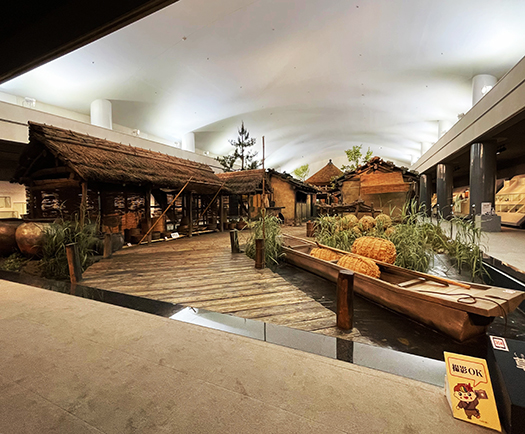


草戸千軒からなかなか脱出できない(笑)。民族的DNAが加齢と共に覚醒される部分があるのでしょうか。もともと歴史考察系のことに興味が強いのと、住宅を考えて行くと「都市」というか集住環境というものへも深く傾斜していくということと思っています。
で、草戸千軒ミュージアム展示では中世のビジュアルとしてたくさんの歴史絵画が資料採用されていて、以前から気になっている「一遍聖絵」の一部なども頻出してくる。この国宝の絵伝は中世の社会を活写していて、無限の想像力を刺激してくれる存在。わたし的には多少は家系的な関係もありそうな先人として一遍(1239-1289年)はあるのですね。古代からの伊予での越智氏・河野氏の系統。
一遍という人物は中世の動乱、承久の変(1221年)のときに敗者側・後鳥羽上皇側に立っていたことでその後没落した父の次男として生まれ、九州で出家修行していたけれど、父親が死亡したときに還俗して伊予の河野氏実家に戻った。けれども33歳くらいになってふたたび家族を捨てて、文字通り出家したとされる。
上の絵図は①一遍が行った「踊り念仏」の様子を伝える京都国立博物館の絵と、③一遍が訪れたとされる中世の市、備前福岡の市を描いた「一遍聖絵」の様子。草戸千軒のことを深掘りしていたら、この備前福岡の市との時代的同時性ではこの絵図がいちばん近縁性が高いことに気がついた。現代のGoogleマップでみると②陸路で約90kmほどですが、瀬戸内海海路ではお隣さんに位置して、成立は同じような経緯だと思われる。
一遍さんは伊予から再度出家し出奔していったのが1272年頃となっているので、草戸千軒の時代推定ともほぼ進行形の同時代。なので絵伝で描かれた中世の市とし均質度が高そうなのですね。
さらに付言すると後鳥羽上皇は何度も「熊野御幸」されたことで有名だけれど、一遍も熊野本宮で出家後の宗教的な最大の邂逅経験をしている。その後も一遍は承久の変で処刑された父・通信の故地奥州・江刺などを歴訪して、やがて「踊り念仏」というパフォーマンスによって時流の最先端文化を創造していくことになる。どうも父祖への思いはしっかりと持っての「出家」と思える。死生を考える宗教としては必然か。
中世人にとっての動乱による体験記憶と、それをバネとした個人の精神性の飛躍をありありと実感できる。


一遍はこの踊り念仏で一般民衆から喝采を受けたとされる。鎌倉期の「新仏教」の最高の盛り上がりとして一遍の布教活動はあったと思うけれど、その「根拠地」として各地の「商工集落」という存在は親和性が高かった。踊り狂いながら南無阿弥陀仏を唱えるという一種のアナーキーな法悦状態が、鎌倉幕府からは「危険な大衆反乱」要因と見なされて、鎌倉都市への入城を拒否されてもいる。
市と新仏教という存在の間に、この時代の強い「民衆性」を見出す思い。
English version⬇
Medieval Upheaval, Cities, and Religion – Kusado-Senken 2023 Revisited – 12
Ippen, the founder of the new Buddhism in the Kamakura period, who created a state of anarchic excitement with his dancing Nembutsu. Buddhism, introduced as a state religion, entered the realm of “people’s salvation. …
It is hard to escape from Kusado-Senken (laughs). Is there a part of your ethnic DNA that awakens with age? I have always had a strong interest in historical studies, and I believe that when we think about housing, we are also deeply inclined toward the “city” or residential environment.
In the Kusado-Senken Museum exhibition, many historical paintings are used as visual materials of the medieval period, and a part of the “Ippen Seine” that I have been interested in for a long time appears frequently. This national treasure, the pictorial biography, is a vivid depiction of medieval society and stimulates unlimited imagination. In my opinion, Ippen (1239-1289) is a predecessor with whom I may have some family connection. He was a descendant of the Ochi and Kono clans in Iyo from ancient times.
Ippen was born as the second son of his father, who had fallen from grace after standing on the side of the defeated Emperor Go-Toba during the Jokyu Rebellion (1221), a period of medieval upheaval. However, it is said that he abandoned his family again at the age of 33 and literally became an ordained priest.
The illustration above is a picture from the Kyoto National Museum showing Ippen’s “Odori Nembutsu” and the “Ippen Seinei” depicting the medieval market of Bizen Fukuoka, which Ippen is said to have visited. When I was digging deeper into Kusado-Senken, I realized that this painting is the most closely related to this Bizen-Fukuoka market in terms of chronological simultaneity. Although it is about 90 km by land according to the modern Google Map, it is located next to the city on the Seto Inland Sea Sea route, and its establishment is thought to be of the same process.
Ippen-san was ordained and left again from Iyo around 1272, which is also roughly the same period in progress as Kusado-Senken’s time estimate. Therefore, it seems that Ippen is highly homogeneous with the medieval city depicted in the picture biography.
I would also like to add that although Emperor Go-Toba is famous for his many visits to Kumano, Ippen also had his greatest religious encounter at Kumano Hongu Shrine after he was ordained. Ippen continued to visit places such as Esashi, Oshu, the birthplace of his father, Tsushin, who was executed in the Jokyu Incident, and eventually created the most advanced culture of the time through his “Odori Nembutsu” performance. It seems to me that he was ordained as a priest while maintaining a strong sense of attachment to his father and ancestors. Is this inevitable for a religion that considers life and death?
We can clearly feel the memories of the upheavals experienced by the medieval people, and the leap in individual spirituality that was triggered by these memories.
It is said that Ippen was applauded by the general public for his dancing Nembutsu. I believe that Ippen’s missionary activities were the climax of the “New Buddhism” of the Kamakura period, and the existence of “commercial and industrial villages” in various regions was highly compatible as a “base” for such activities. The anarchic state of Dharma joy of dancing and chanting Namu Amidabutsu was regarded by the Kamakura Shogunate as a factor of “dangerous mass revolt” and was even denied entry to the city of Kamakura.
Between the existence of the city and the new Buddhism, we find the strong “popular nature” of this period.
Posted on 12月 24th, 2023 by 三木 奎吾
Filed under: 住宅マーケティング, 日本社会・文化研究







コメントを投稿
「※誹謗中傷や、悪意のある書き込み、営利目的などのコメントを防ぐために、投稿された全てのコメントは一時的に保留されますのでご了承ください。」
You must be logged in to post a comment.